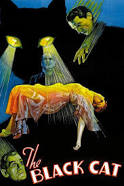
Cum grano salis. Humanum est errare.
American Honeymooners Peter Alison (David Manners) and his wife Joan (Julie Bishop) meet Dr. Vitus Werdegast (Bela Lugosi) on a train in Hungary. Werdegast is a psychiatrist. Eighteen years earlier he went to war leaving his wife behind. He spent the last 15 years in a prison camp in Siberia. Werdegast says he is on the way to see an old friend, Hjalmar Poelzig (Boris Karloff).
Joan is injured when the bus they share crashes in a rain storm. They take her to Poelzig’s near-by home. He built it on the ruins of Fort Marmorus. Poelzig was the commander there during the war. While Joan recuperates Werdegast confronts Poelzig accusing him of causing the death of thousands of Austro-Hungarian soldiers. He also accuses Poelzig of stealing his wife Karen (Lucille Lund) and his child while he was in prison and demands to know what happened to them. Poelzig shows Werdegast his wife. She is in a sort of suspended animation. Poelzig has many women in suspended animation. He keeps them as trophies. He also tells Werdegast that his daughter, who was also named Karen, died. That, however, is a lie. Werdegast’s daughter Karen (Lucille Lund) is really alive and Poelzig has taken her as his wife and he keeps her in a zombie-like state.
Werdegast knows that Poelzig plans to sacrifice Joan in a satanic ritual thus adding her to his collection. Poelzig challenges Werdegast to a game of chess. If Werdegast wins then Joan and her husband can go on their way. If Poelzig wins then Werdegast will not try to stand in the way of Poelzig’s scheme. Werdegast looses. Thus begins the Satanic Mass.
“The Black Cat” was released in 1934 and was directed by Edgar G. Ulmer. This is the first of the eight movies that Lugosi and Karloff did together. “The Black Cat” is a pre-code horror movie. Much of it is confusing. What is the point of putting women in glass cages? Other than to prove that you’re a freak. The movie is cryptic and filled with symbolism. Werdegast has a rabid fear of black cats, which doesn’t have anything to do with the movie other than the title. Nor does it have anything to do with Poe’s story. I’ve heard explanations of it, but I haven’t heard one that really makes sense.
Other plot points seem to be intentionally vague. Even though the movie is pre-code they don’t come right out and state that there are hints of incest and necrophilia in the movie. Although they had no problem with skinning a guy. Even though Poelzig is a Satanist and a murderer, Werdegast also needs some serious therapy. Perhaps things were cut out that would have made the movie a little clearer. I know there were scenes that were cut for re-release. Some nudity in the black mass and the skinning scene had some nasty parts removed.
Even though parts of the movie are a little strange, it’s the strange that adds to the creepiness. The symbolism, the light and shadows, the unusual house itself all add to the atmosphere. It’s sinister times two. You know that Karloff is a bad guy. It’s in his face and his body language, not to mention his deeds. Lugosi is the unknown factor. Is he the good guy or has his time in prison made him something else? Even though it’s confusing it’s still quite evil, and very sadistic. There are lots of noir aspects sprinkled throughout.
The Latin that Karloff recites during the black mass has nothing to do with a black mass. It’s mostly just random sayings. For example: Cum grano salis means; with a grain of salt. Humanum est errare means; to err is human.

